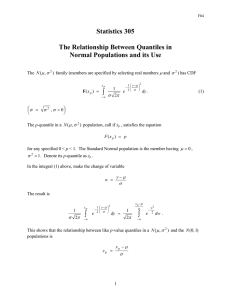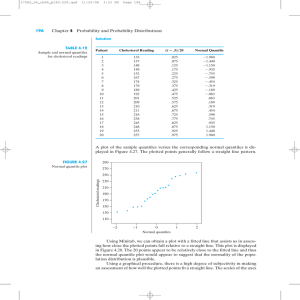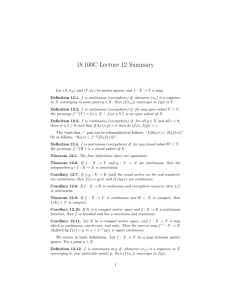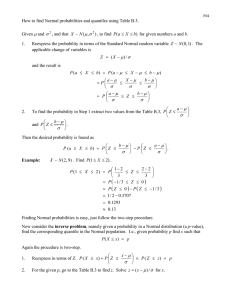QUANTILES: Feb. 4, 2005, R. Dudley, 18.465 notes Let If a
advertisement
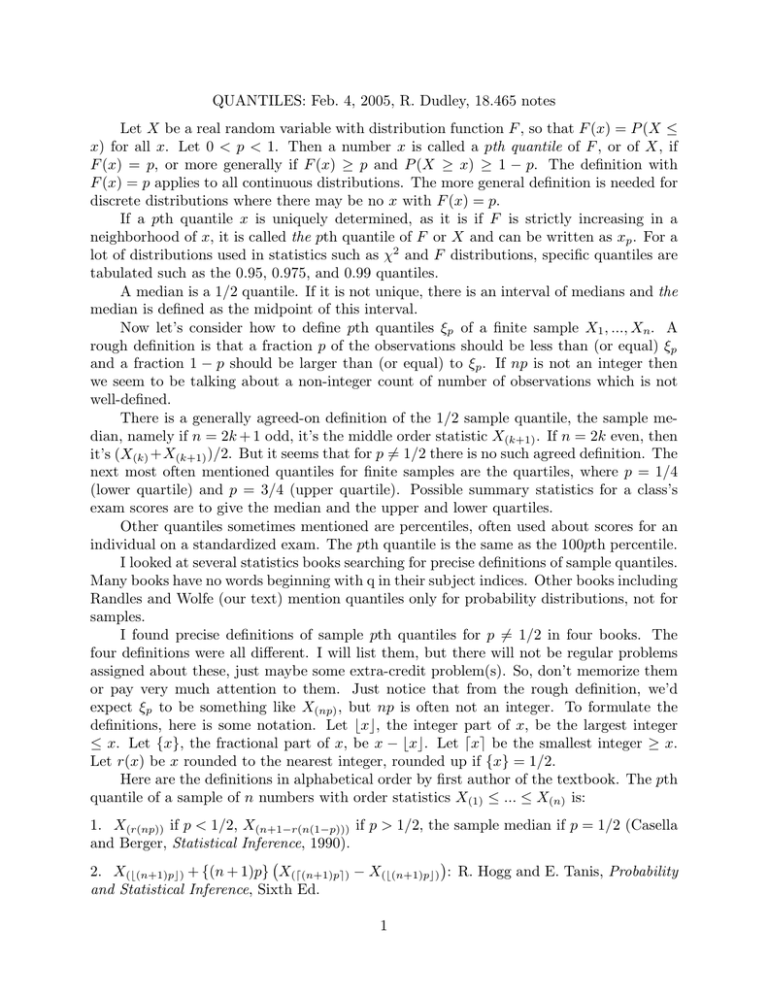
QUANTILES: Feb. 4, 2005, R. Dudley, 18.465 notes
Let X be a real random variable with distribution function F , so that F (x) = P (X ≤
x) for all x. Let 0 < p < 1. Then a number x is called a pth quantile of F , or of X, if
F (x) = p, or more generally if F (x) ≥ p and P (X ≥ x) ≥ 1 − p. The definition with
F (x) = p applies to all continuous distributions. The more general definition is needed for
discrete distributions where there may be no x with F (x) = p.
If a pth quantile x is uniquely determined, as it is if F is strictly increasing in a
neighborhood of x, it is called the pth quantile of F or X and can be written as xp . For a
lot of distributions used in statistics such as χ2 and F distributions, specific quantiles are
tabulated such as the 0.95, 0.975, and 0.99 quantiles.
A median is a 1/2 quantile. If it is not unique, there is an interval of medians and the
median is defined as the midpoint of this interval.
Now let’s consider how to define pth quantiles ξp of a finite sample X1 , ..., Xn. A
rough definition is that a fraction p of the observations should be less than (or equal) ξp
and a fraction 1 − p should be larger than (or equal) to ξp . If np is not an integer then
we seem to be talking about a non-integer count of number of observations which is not
well-defined.
There is a generally agreed-on definition of the 1/2 sample quantile, the sample median, namely if n = 2k + 1 odd, it’s the middle order statistic X(k+1) . If n = 2k even, then
it’s (X(k) +X(k+1) )/2. But it seems that for p = 1/2 there is no such agreed definition. The
next most often mentioned quantiles for finite samples are the quartiles, where p = 1/4
(lower quartile) and p = 3/4 (upper quartile). Possible summary statistics for a class’s
exam scores are to give the median and the upper and lower quartiles.
Other quantiles sometimes mentioned are percentiles, often used about scores for an
individual on a standardized exam. The pth quantile is the same as the 100pth percentile.
I looked at several statistics books searching for precise definitions of sample quantiles.
Many books have no words beginning with q in their subject indices. Other books including
Randles and Wolfe (our text) mention quantiles only for probability distributions, not for
samples.
I found precise definitions of sample pth quantiles for p = 1/2 in four books. The
four definitions were all different. I will list them, but there will not be regular problems
assigned about these, just maybe some extra-credit problem(s). So, don’t memorize them
or pay very much attention to them. Just notice that from the rough definition, we’d
expect ξp to be something like X(np) , but np is often not an integer. To formulate the
definitions, here is some notation. Let x, the integer part of x, be the largest integer
≤ x. Let {x}, the fractional part of x, be x − x. Let x be the smallest integer ≥ x.
Let r(x) be x rounded to the nearest integer, rounded up if {x} = 1/2.
Here are the definitions in alphabetical order by first author of the textbook. The pth
quantile of a sample of n numbers with order statistics X(1) ≤ ... ≤ X(n) is:
1. X(r(np)) if p < 1/2, X(n+1−r(n(1−p))) if p > 1/2, the sample median if p = 1/2 (Casella
and Berger, Statistical Inference, 1990).
�
�
2. X((n+1)p) + {(n + 1)p} X((n+1)p) − X((n+1)p) : R. Hogg and E. Tanis, Probability
and Statistical Inference, Sixth Ed.
1
3. X(np) if np is not an integer, or if it is, (X(np) + X(np+1) )/2: R. A. Johnson, Miller
and Freund’s Probability and Statistics for Engineers 5th ed., 1994.
4. X(r((n+1)p)) , given just for p = 1/4 or 3/4 (would be undefined if (n + 1)p < 1/2 or
≥ n + (1/2)): Mendenhall and Sincich, Statistics for Engineering and the Sciences.
Some of the apparent complexity of some definitions is motivated by a consideration
of symmetry: if all Xi are replaced by −Xi , reversing the order of the order statistics while
also changing their signs, one would like ξp for the −Xi to be −ξ1−p for the Xi .
Since there is no agreement on a precise definition of sample quantiles other than the
sample median, one can just keep in mind the rough definition.
2


